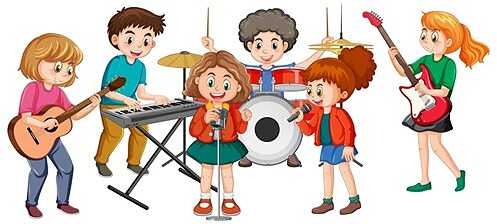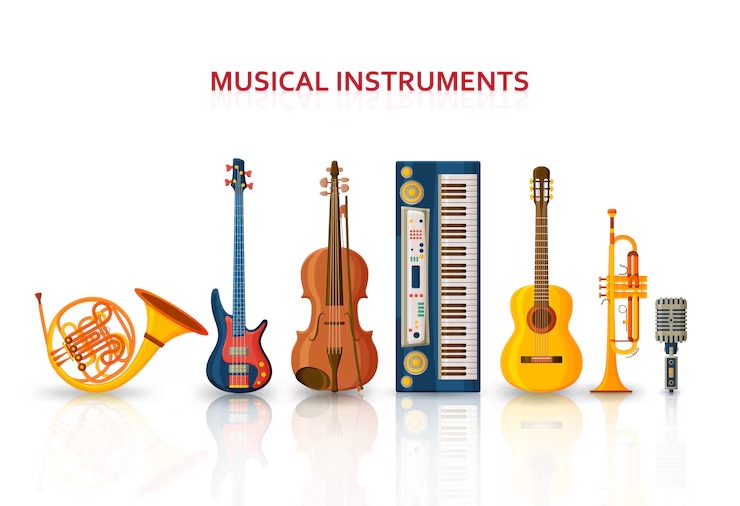Watching your child showing interest in music is a beautiful moment for a parent might not be with right instrument. Whether they’re tapping a rhythm on the table or humming a tune out of the blue, it’s often the first sign that there’s a little musician growing inside them. But once this spark is visible, the big question arises — which musical instrument should they learn first?
Choosing the right instrument is not as simple as walking into a store and picking the one that looks shiny or sounds nice. It’s about matching your child’s personality, age, physical abilities, and interest with an instrument that fits them well like choosing the right pair of shoes for a long journey.
Let’s help you choose an instrument that doesn’t just teach music but builds discipline, confidence, patience, and joy in your child’s life. 🎶

1. Why Choosing the Right Instrument Matters
Choosing the right instrument for your child is not just about picking something cool or popular. It’s about finding the perfect match between your child’s personality, interest, physical comfort, and musical ability. The right instrument can help a child build confidence, stay committed to learning, and even discover a lifelong passion.
Imagine gifting a child a drum kit when they are sensitive to loud noise or handing them a large cello when their hands can barely hold the bow. These situations lead to frustration instead of joy. That’s why this first step is so important. When chosen thoughtfully, an instrument becomes a best friend, not a burden.
2. Understanding Your Child’s Interest and Personality 🎭
Before rushing to the music store, observe your child closely. Are they calm and introspective? Or energetic and outgoing? These traits play a role in choosing the right instrument.
- Children who are gentle or quiet might enjoy the piano, violin, or flute.
- Kids with a strong personality or love for rhythm might thrive with drums, tabla, or guitar.
- Social children who like working in teams may enjoy instruments that are often part of bands or orchestras, like saxophones, violins, or percussion.
Ask questions like:
- 👉 What kind of music does my child enjoy?
- 👉 Do they like to sing or hum?
- 👉 Have they shown interest in rhythm or melody?
Listening to your child and involving them in the decision will help them feel ownership and enthusiasm.
Also Read: Free Checklist: 10 Music Career Path Every One Should Know
3. Matching the Instrument with Your Child’s Age and Body Type 👶
Not every instrument is suitable for every child—especially when it comes to size and age. A small child may struggle to carry or play certain instruments. For example:
- Piano and keyboard are excellent starting points for even 4–5-year-olds.
- Guitars and violins come in smaller sizes (like 1/2 or 3/4), which are great for younger children.
- Wind instruments like clarinets or saxophones usually suit children over 8–9 years due to lung capacity and hand span.
Also consider hand strength, finger reach, and posture. If an instrument doesn’t physically suit the child, it can cause frustration, poor posture, or even minor injuries. A trial session with an instructor can help check if the child feels comfortable.
4. The Role of Sound and Tone Preference 🎧
Sound matters more than we realize. Children may feel emotionally connected to a particular tone. Some love the deep, mellow tone of a cello. Others are drawn to the brightness of a flute or the upbeat jingle of a ukulele.
Let your child listen to different instruments through videos, live demos, or music classes. You’ll often notice an instinctive attraction to a certain sound. That’s your cue.
Remember: when a child loves the sound, they’re more likely to keep practicing and stay motivated.
5. Popular Instruments for Beginners: Which One Fits? 🎸

Here are a few beginner-friendly instruments and who they might suit:
- Keyboard/Piano – Great for understanding melody and rhythm. Builds a strong musical foundation.
- Guitar – Versatile and cool! Good for rhythmic learners and those who love singing.
- Violin – Ideal for disciplined learners. Teaches ear training and patience.
- Tabla/Dholak/Mridangam – Amazing for children with a sense of rhythm. Helps build hand coordination.
- Flute or Recorder – Easy to start with. Great for breath control and melody.
- Vocals – Yes, the voice is an instrument too! Perfect for expressive, confident children.
Always balance your child’s interest with what’s age-appropriate and accessible.
6. Learning Style Matters – Visual, Auditory, or Kinesthetic? 🎯
Every child learns differently. And this affects how well they can connect with a musical instrument.
- Visual learners understand things better when they can see how something works. They might enjoy instruments like the piano or keyboard, where keys are laid out in front of them. They can watch finger placement and learn through sheet music.
- Auditory learners rely on their ears. These kids enjoy singing, listening, and can easily match pitch or rhythm. They may do well with flute, violin, or even vocals.
- Kinesthetic learners learn through movement and touch. They like physical interaction, so percussion instruments like tabla, drums, or guitar might be perfect for them.
A simple way to figure this out? Watch how your child solves problems or remembers songs—do they repeat it aloud (auditory), watch videos (visual), or try it themselves (kinesthetic)? The answer will guide you.
7. Budget and Accessibility – Start Small, Grow Later 💸
Instruments can vary greatly in cost, and that’s something every parent needs to think about—especially if you’re unsure how long the child will stick with it.
Good news: You don’t need to invest in a brand-new instrument right away. Many schools and music centers offer rentals or second-hand instruments in great condition. This is ideal when your child is just beginning and still exploring.
Also, some instruments need extra accessories—like bows, tuners, reeds, or stands—which can add to the cost. Always ask:
- Is this a one-time purchase or will it need frequent servicing?
- Is it easy to carry to school or classes?
- Can I find a good teacher or class nearby?
Choosing an instrument that’s both affordable and accessible gives your child the freedom to explore without pressure.
8. Teacher Availability and Learning Support 🧑🏫
Even if your child picks the perfect instrument, finding the right teacher is just as important. A good teacher can make the learning experience joyful and stress-free.
Check locally or online to see if experienced music instructors are available for the chosen instrument. Not all instruments have equal teaching support—some rare or classical Indian instruments might be harder to find tutors for in certain areas.
Also, look for classes that offer:
- Trial sessions
- Student performances
- Parent feedback
- Fun, interactive sessions
Bonus Tip: If your child is shy, group classes may help build confidence. If they’re more focused, one-on-one classes can offer deeper attention.
9. What Do Stats Say? 📊
If you’re wondering how important early music education really is, According to resource published by the National Association for Music Education (NAfME), children involved in music from a young age show improvements in:
- Language development
- Memory
- Emotional intelligence
- Social skills
- Academic performance
This means that helping your child find the right instrument isn’t just about music—it boosts overall brain development.
This is why schools and experts across the world now encourage early and personalized music learning.
10. Letting the Child Explore – Try Before You Buy 🛤️
Sometimes, even after doing all the research, the child might not like the instrument. That’s okay. The best solution? Try before you buy.
Many music centers, schools, and even stores allow kids to try different instruments in demo sessions or workshops. Let your child hold, play, and feel the instrument before making a decision. If possible, allow them to attend a “music discovery class” where they can test a few options in one go.
Remember: Don’t force it. Sometimes, a child needs to explore more than one instrument before finding the right fit. Be patient, it’s all part of the journey.
11. Observe Their Response After Trial Lessons
Sometimes, the best way to find the right instrument is simply to try it out. Many music schools or private teachers offer trial classes or demo sessions. These are incredibly helpful because they let your child explore the instrument hands-on before making a long-term commitment.
What should you observe?
- Body language: Are they relaxed and engaged, or frustrated and disinterested?
- Excitement level: Do they talk about the lesson afterward? Do they ask when the next one is?
- Understanding: Are they able to follow along, or do they struggle to grasp the basics?
Letting your child experiment through real exposure is often the most honest way to know if it’s truly their thing or just a passing interest.
12. Don’t Be Afraid to Switch Instruments
Many parents think that once their child picks an instrument, they must stick to it. But in reality, it’s perfectly okay to switch. Especially in the beginning stages, exploring different sounds and styles is part of developing a deep connection to music.
If your child starts with the keyboard but suddenly finds joy in strumming a guitar or gets curious about the rhythm of drums, support that shift. Music is a journey, and sometimes the path takes a few turns before landing in the right place.
Reminder: Choosing the “wrong” instrument first doesn’t mean failure—it means learning what suits your child better!
Choosing the Right Instrument Is a Journey, Not a Race
Choosing the right musical instrument for your child isn’t just about sound—it’s about personality, patience, passion, and a little bit of play. As parents, your role is to guide, observe, and support without pressuring. Let them explore, make mistakes, and grow.
Whether your child ends up as a casual player or a stage performer, what matters most is that they develop a love for music that can last a lifetime.
🎵 Because when a child connects with the right instrument, they don’t just make music, they tell stories, express feelings, and find their own rhythm in the world.


